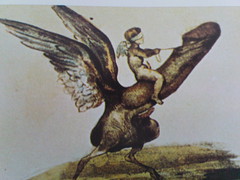In the history of world erotica I present you with Le Poitevin’s diableries.
From the Les Diableries Erotiques by Eugène le Poitevin
Eugène le Poitevin (1806 – 1870) was a French artist, author of Les Diableries Erotiques.
He is an underrated figure in the history of French erotica and his engraving above from the aforementioned Les Diableries Erotiques is icon of erotic art #42.
Diableries are an interesting genre and illustrates how — before the “invention” of erotica and pornography — body parts and the people possessing them were used for subversive purposes, here as a form of satirical pornography or pornographic satire. The genre goes back to Rabelais, although his masterpiece Gargantua and Pantagruel was more emetic than erotic.
Gargantua and Pantagruel by François Rabelais, illustrated by Gustave Doré in 1873
Cardinal Armand de Rohan-Soubise by anonymous
Anonymous satirical caricature of the Cardinal Armand de Rohan-Soubise (1717-1757); this engraving is a good example of “pornography” as a tool for political subversion during France’s ancien régime.
Of course, artists such as Le Poitevin deserve a place in the history of derision, a playful and benign derision that is turned toward ourselves, toward the very core of human nature. As such it is also a piece of toilet philosophy.
Remarkably, the writeup on a Poitevin engraving not depicted here in my edition of Erotic Art of the Masters the 18th, 19th, 20th Centuries Art & Artists , author and editor Bradley Smith notes “penises and vaginas fly through the air like butterflies, are gathered in baskets and, personified, play games with adults and children.” This quote echoes the following by Deleuze and Guattari, “Flying anuses, speeding vaginas, there is no castration” (A Thousand Plateaus, p. 32).




The phallus bird creature by Poitevin is very similar to a Roman bronze tintinnabulum from the 1st century AD. It has three little bells on chains which hang from the tip of the phallus and the tips of both wings.
There are a number of these creatures, (phallus men, animals and birds) reproduced in the book “Sex or Symbol, erotic images of Greece and Rome” by Catherine Johns.
There is also this amusing quote from the Malleus Maleficarum…
“And what then is to be thought of those witches who in this way sometimes collect male organs in great numbers, as many as twenty or thirty members together, and put them in a bird’s nest, or shut them up in a box, where they move themselves like living members, and eat oats and corn, as has been seen by many and is a matter of common report?
For a certain man tells us that, when he had lost his member, he approached a known witch to ask her to restore it to him. She told the afflicted man to climb a certain tree, and that he might take which he liked out of a nest in which there were several members. And when he tried to take a big one, the witch said : You must not take that one; adding, because it belonged to a parish priest.”
Thanks Paul, I’ll include your comments in the wiki!
http://www.barakatpublications.com/XXXVI/roman_relief.jpg
Here is one in stone….
http://www.scholarsresource.com/images/thumbnails/192/j/jic0357e.jpg
A similar tintinnabulum….
http://commons.wikimedia.org/wiki/File:Tintinnabulum-Fund_in_Herculaneum.jpg
This tintinnabulum is also rather amusing …..
Thanks for those, I’ve never taken the time to delve into Roman and Greek culture, it’s a universe in itself. There are actually two Western societies, before the ancients and after. The subversive tintinnabulum is perhaps a good entrypoint to start my quest for Roman and Greek counterculture, if counterculture is possible in such an “unmediated” society.
Here is a very good one.
Pingback: Never mind the bollocks, here’s Rabelais « Jahsonic